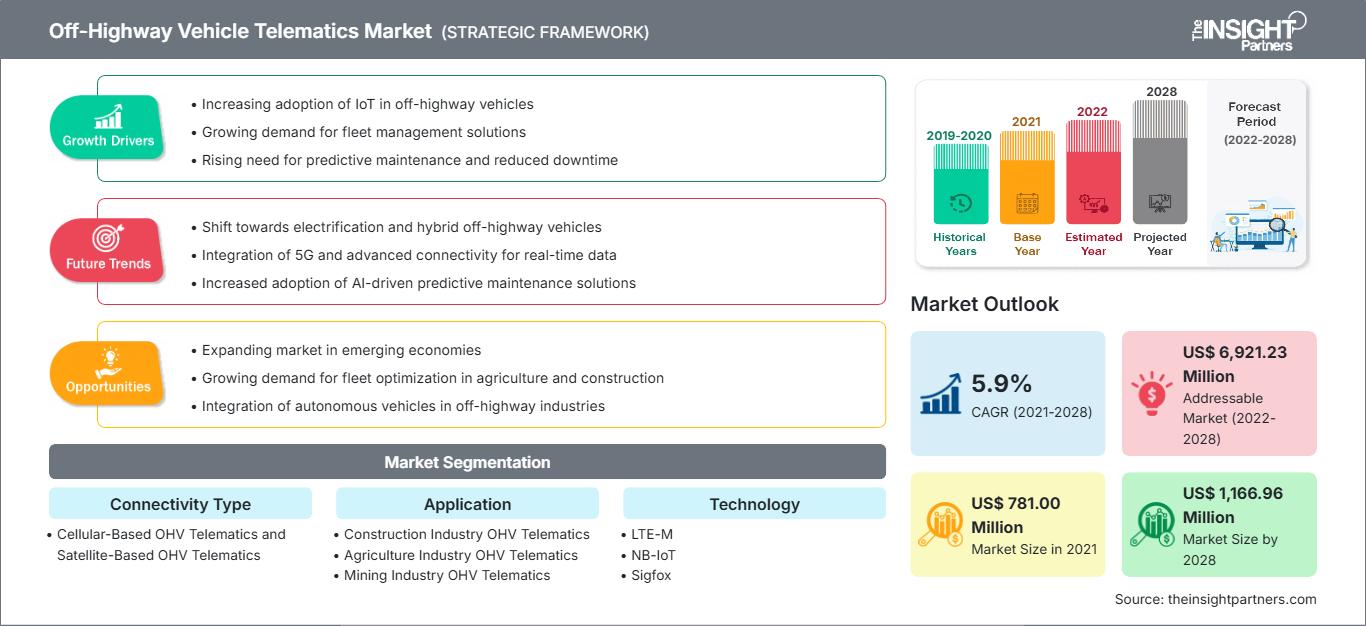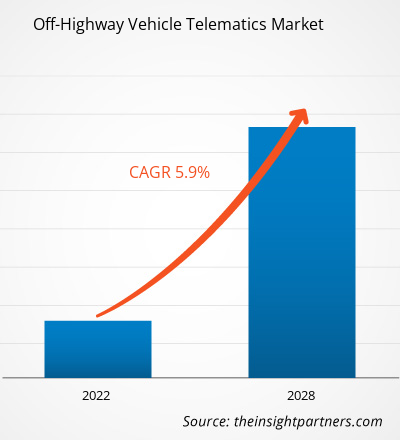Il mercato della telematica per veicoli fuoristrada è stato valutato a 781,00 milioni di dollari nel 2021 e si prevede che raggiungerà i 1.166,96 milioni di dollari entro il 2028; si stima che registrerà un CAGR del 5,9% nel periodo di previsione dal 2021 al 2028.
Il settore della telematica si è evoluto rapidamente grazie ai progressi tecnologici. Alcune nuove tendenze all'orizzonte che devono essere analizzate per rimanere un passo avanti alla concorrenza sono:
- Rete interconnessa rapida: l'aggiornamento alle reti 4G e 5G offre un'esperienza completamente nuova in termini di larghezza di banda, upload di dati più rapidi e download di feedback, con conseguente maggiore disponibilità di set di dati in tempo reale, sicurezza del conducente in tempo reale, manutenzione della flotta ed efficienza della flotta.
- Abilitazione cloud: i sensori sono collegati a diversi sottosistemi di un veicolo. Questi sistemi scambiano costantemente enormi quantità di dati. Sensori per il monitoraggio della pressione degli pneumatici, l'acquisizione video e il monitoraggio della temperatura sono solo alcuni esempi. I progressi nella tecnologia cloud hanno reso possibile l'archiviazione, la gestione e l'utilizzo efficiente di enormi quantità di dati.
- Adozione da parte delle piccole imprese: la telematica è diventata più di una semplice tendenza per i fornitori di servizi e i proprietari di piccole flotte. Molte start-up offrono soluzioni telematiche economiche ma efficaci, reperibili sul mercato locale per i proprietari di flotte più piccole.
- Accesso diretto ai dati e dashboard intuitive: gli utenti hanno accesso diretto ai dati per il processo decisionale. Singoli conducenti, responsabili delle spedizioni, un'agenzia centrale di gestione flotte o un ufficio locale e i franchisee traggono vantaggio da questi dati. A tutti gli stakeholder vengono fornite dashboard personalizzate basate sui ruoli con accesso limitato per prendere decisioni informate in tempo reale in base alle loro specifiche esigenze di servizio, agli orari di consegna o di arrivo, ai vincoli di movimentazione e ad altri fattori. Ciò aiuta anche le aziende di gestione flotte a mantenere una scheda di valutazione dei conducenti basata sul comportamento e ha implicazioni legali. Molte aziende scambiano dati anche con il settore delle spedizioni e dei trasporti per migliorare la pianificazione degli attracchi. Ciò favorisce una pianificazione efficace e si traduce in conducenti più felici e produttivi.
Pertanto, i crescenti progressi tecnologici nella telematica dei veicoli fuoristrada guideranno la crescita del mercato della telematica dei veicoli fuoristrada.
Personalizza questo rapporto in base alle tue esigenze
Potrai personalizzare gratuitamente qualsiasi rapporto, comprese parti di questo rapporto, o analisi a livello di paese, pacchetto dati Excel, oltre a usufruire di grandi offerte e sconti per start-up e università
Mercato della telematica per veicoli fuoristrada: Approfondimenti strategici

-
Ottieni le principali tendenze chiave del mercato di questo rapporto.Questo campione GRATUITO includerà l'analisi dei dati, che vanno dalle tendenze di mercato alle stime e alle previsioni.
La rapida trasformazione digitale del settore edile richiede l'adozione di nuove tecnologie che offrono nuove prospettive per il mercato della telematica per veicoli off-highway. La telematica per le attrezzature edili aiuta le aziende a tracciare la posizione e le prestazioni delle proprie attrezzature, a monitorare l'utilizzo delle risorse e a verificarne l'efficacia. Se un'attrezzatura è sottoutilizzata, potrebbe essere spostata in un altro luogo in cui è necessaria. In questo modo, la telematica per le attrezzature edili migliora l'efficienza complessiva, con un impatto positivo sul mercato della telematica off-highway.
Inoltre, la crescente attività edilizia, sia nel settore privato che in quello pubblico, probabilmente favorirà la crescita del mercato. Diversi progetti infrastrutturali sono in corso o pianificati in paesi come India, Filippine, Emirati Arabi Uniti, Arabia Saudita, Egitto, Nigeria e Stati Uniti. Ad esempio, il governo indiano ha stanziato un budget di 1,12 miliardi di dollari per l'anno fiscale in corso nell'ambito del programma "Cento Città Intelligenti" nel Bilancio dell'Unione per il 2014-2015. Inoltre, il governo prevede di investire 650 miliardi di dollari in vari progetti urbani e infrastrutturali in tutto il paese nei prossimi 20 anni, il che, a sua volta, sosterrebbe la crescita del mercato della telematica per veicoli fuoristrada. Sono in corso diversi progetti infrastrutturali in Medio Oriente, tra cui Jeddah Economic City (Arabia Saudita), Masdar City (Emirati Arabi Uniti) e Dubailand (Emirati Arabi Uniti). Questa rapida crescita dei progetti infrastrutturali probabilmente aumenterà la domanda di attrezzature per l'edilizia.
Impatto della pandemia di COVID-19 sul mercato della telematica per veicoli fuoristrada in Nord America
Il Nord America è una delle regioni leader in termini di sviluppo e adozione di nuove tecnologie grazie a politiche governative favorevoli che promuovono l'innovazione e rafforzano le capacità infrastrutturali. Pertanto, qualsiasi impatto negativo sulla crescita del settore industriale ostacola la crescita economica della regione. Attualmente, gli Stati Uniti sono il paese più colpito al mondo dall'epidemia di COVID-19. La dipendenza del mercato della telematica per veicoli fuoristrada dagli operatori manifatturieri, come le case automobilistiche e i produttori di componenti per auto, è stata evidenziata dalla recente pausa produttiva dovuta all'epidemia di COVID-19. Anche prima dell'epidemia di COVID-19, il settore automobilistico si trovava ad affrontare sfide come la mobilità elettrica, le auto senza conducente, le fabbriche automatizzate e il ride-sharing. L'industria automobilistica sta subendo una grave battuta d'arresto a causa delle severe restrizioni ai viaggi, della chiusura delle attività produttive internazionali, del calo delle vendite di automobili e dei licenziamenti di massa. È probabile che la domanda complessiva di telematica per veicoli fuoristrada aumenti una volta che le industrie avranno raggiunto le normali condizioni operative. A causa dell'aumento della domanda di automobili, delle politiche governative favorevoli e dei crescenti investimenti dei paesi nordamericani in tecnologie avanzate, il Nord America registra una forte domanda di telematica per veicoli fuoristrada.
Approfondimenti sul mercato della telematica per veicoli fuoristrada
Crescente integrazione dell'IoT
Sistemi microelettromeccanici, Internet e tecnologie wireless si sono uniti per formare l'Internet delle cose (IoT). I proprietari di flotte possono utilizzare l'IoT per monitorare da remoto la velocità del veicolo, la pressione degli pneumatici, il consumo di carburante e il comportamento del conducente, migliorando ulteriormente l'efficienza del veicolo e del conducente. Gli sviluppatori di sistemi telematici possono utilizzare questa tecnologia per creare soluzioni telematiche su misura per esigenze specifiche nei settori minerario, agricolo ed edile, dove i costi operativi sono elevati. I fornitori di servizi e gli operatori di flotte possono adottare l'analisi predittiva combinando l'IoT e la tecnologia di gestione della flotta. Ciò fornisce il contesto per realizzare una gestione proattiva e un vantaggio competitivo in diverse aree operative critiche. I sensori IoT nei prodotti orientati al servizio, come i condizionatori d'aria, possono notificare una chiamata di assistenza solo quando necessario, anziché a intervalli regolari. Il monitoraggio basato sulle condizioni riduce i costi di assistenza, aumentando al contempo la precisione e il servizio clienti. Una delle spese più significative per qualsiasi flotta è il carburante. Integrando i sensori IoT nel sistema telematico, i gestori delle flotte possono ottenere una visione quasi in tempo reale del consumo di carburante e delle spese dei veicoli. Ciò consente loro di individuare chi necessita di formazione sui comportamenti di guida efficaci e di monitorare le spese operative e gli stili di guida illeciti, come il minimo, che può comportare uno spreco di carburante. Inoltre, tutte le flotte attribuiscono grande importanza alla sicurezza. Con l'aumento degli incidenti dovuti a eccesso di velocità, frenate brusche e guida aggressiva, i gestori delle flotte possono utilizzare il coaching dei conducenti e l'educazione alla sicurezza per affrontare i comportamenti di guida indesiderati. Pertanto, la crescente integrazione dell'IoT può aprire nuove possibilità commerciali.
Approfondimenti di mercato basati sul tipo di connettività
In base al tipo di connettività, il mercato della telematica per veicoli fuoristrada è segmentato in telematica per veicoli fuoristrada basata su rete cellulare e telematica per veicoli fuoristrada basata su rete satellitare. Il segmento della telematica per veicoli fuoristrada basata su tecnologia cellulare ha guidato il mercato della telematica per veicoli fuoristrada con una quota del 77,6% nel 2020.
Approfondimenti di mercato basati sulle applicazioni
In base all'applicazione, il mercato della telematica per veicoli fuoristrada può essere segmentato in telematica per veicoli fuoristrada per il settore edile, telematica per veicoli fuoristrada per il settore agricolo, telematica per veicoli fuoristrada per il settore minerario e altri. Il segmento della telematica per veicoli fuoristrada per il settore edile ha guidato il mercato della telematica per veicoli fuoristrada con una quota del 64,3% nel 2020.
Mercato della telematica per veicoli fuoristradaLe tendenze regionali e i fattori che influenzano il mercato della telematica per veicoli fuoristrada durante il periodo di previsione sono stati ampiamente spiegati dagli analisti di The Insight Partners. Questa sezione analizza anche i segmenti e la geografia del mercato della telematica per veicoli fuoristrada in Nord America, Europa, Asia-Pacifico, Medio Oriente e Africa, America meridionale e centrale.
Ambito del rapporto sul mercato della telematica per veicoli fuoristrada
| Attributo del rapporto | Dettagli |
|---|---|
| Dimensioni del mercato in 2021 | US$ 781.00 Million |
| Dimensioni del mercato per 2028 | US$ 1,166.96 Million |
| CAGR globale (2021 - 2028) | 5.9% |
| Dati storici | 2019-2020 |
| Periodo di previsione | 2022-2028 |
| Segmenti coperti |
By Tipo di connettività
|
| Regioni e paesi coperti |
Nord America
|
| Leader di mercato e profili aziendali chiave |
|
Densità degli operatori del mercato della telematica per veicoli fuoristrada: comprendere il suo impatto sulle dinamiche aziendali
Il mercato della telematica per veicoli fuoristrada è in rapida crescita, trainato dalla crescente domanda degli utenti finali, dovuta a fattori quali l'evoluzione delle preferenze dei consumatori, i progressi tecnologici e una maggiore consapevolezza dei vantaggi del prodotto. Con l'aumento della domanda, le aziende stanno ampliando la propria offerta, innovando per soddisfare le esigenze dei consumatori e sfruttando le tendenze emergenti, alimentando ulteriormente la crescita del mercato.

- Ottieni il Mercato della telematica per veicoli fuoristrada Panoramica dei principali attori chiave
Approfondimenti di mercato basati sulla tecnologia
In base alla tecnologia, il mercato della telematica per veicoli fuoristrada può essere segmentato in LTE-M, NB-IoT, Sigfox e altri. LTE-M ha guidato il mercato della telematica per veicoli fuoristrada con una quota dell'82,3% nel 2020.
Gli operatori che operano nel mercato della telematica per veicoli fuoristrada adottano strategie come fusioni, acquisizioni e iniziative di mercato per mantenere le proprie posizioni sul mercato. Di seguito sono elencati alcuni sviluppi dei principali attori:
- A gennaio 2022, Stoneridge e Valens Semiconductor hanno stretto partnership per lo sviluppo di soluzioni di sicurezza per trattori e rimorchi tramite connettività avanzata e visione, che a loro volta avranno un impatto positivo sul mercato della telematica off-highway.
- Ad agosto 2020, la famiglia di controller HY-TTC 500 è stata certificata per l'uso su strada. HY-TTC 500 è composta da unità di controllo di sicurezza di fascia alta, progettate per creare un'architettura elettronica centralizzata e sicura. Certificazione del controller HY-TTC 500, un prodotto di TTControl, certificato per l'uso su strada secondo la norma ISO 26262.
Profili aziendali
- Omnitracs, LLC
- ORBCOMM
- Stoneridge, Inc.
- Teletrac Navman
- TomTom International BV
- Trackunit A/S
- Wacker Neuson
- Zonar Systems Inc.
- TTCONTROL GMBH
- ACTIA Group
- Analisi storica (2 anni), anno base, previsione (7 anni) con CAGR
- Analisi PEST e SWOT
- Valore/volume delle dimensioni del mercato - Globale, Regionale, Nazionale
- Industria e panorama competitivo
- Set di dati Excel
Report recenti
Rapporti correlati
Testimonianze
Motivo dell'acquisto
- Processo decisionale informato
- Comprensione delle dinamiche di mercato
- Analisi competitiva
- Analisi dei clienti
- Previsioni di mercato
- Mitigazione del rischio
- Pianificazione strategica
- Giustificazione degli investimenti
- Identificazione dei mercati emergenti
- Miglioramento delle strategie di marketing
- Aumento dell'efficienza operativa
- Allineamento alle tendenze normative






















 Ottieni un campione gratuito per - Mercato della telematica per veicoli fuoristrada
Ottieni un campione gratuito per - Mercato della telematica per veicoli fuoristrada